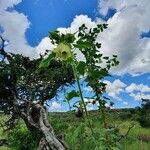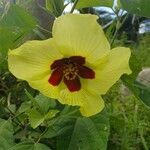Perennial herb, shrub 0.05-3.05 m high, sometimes scandent; indumentum variable, glandular, stellate-hispid or aculeate. Leaves suborbicular in outline, 3-5(7)-palmatilobed, margins serrate, apex of lobes acute, base truncate to cordate, 5-9-nerved. Flowers solitary or in terminal racemes by reduction of upper leaves, up to 90 mm in diam.; peduncles 10-15(50) mm long, articulated above middle. Epicalyx of 10 filiform bracts. Calyx accrescent, somewhat scarious, lobes broadly elliptic, joined ± halfway. Petals yellow, purple-centred. Staminal tube up to 15 mm long; filaments up to 5 mm long. Flowering time Oct.-Jan. Fruit a winged capsule, scarious, usually hispid; valves aristate. Seeds irregularly reniform, glabrous.
A herb or low shrub. It grows 1.5 m tall. The leaves are alternate and can be simple or have 3-5 lobes. The leaves at the top of the plant are oval. They are 2-15 cm long by 1-18 cm wide. They are hairy and have teeth along the edge. The flowers occur singly in the axils of leaves. They are pale yellow with a dark red spot at the base. They are about 3 cm long. The fruit is a capsule that is a flattened round shape. It is about 1 cm long.
Leaf-lamina 3–15 × 3–15 cm., ovate to suborbicular; not lobed to deeply 3–5 (7)-palmatilobed, with a variable indumentum (as on the stems) but stellatehispid or bifurcate hairs, rather rare on the stems, are more frequent especially on the under surface, margin serrate, base truncate to cordate 5–9-nerved; lobes acute or bluntish; petiole 2–7 (18) cm. long, hairy like the stems; stipules 3–5 mm. long, filiform.
Shrub or perennial herb up to 1·5 m. tall, sometimes scandent or scrambling; stems terete, nearly glabrous or with a very variable indumentum, sometimes tomentose or tomentellous, often glandular, sometimes hispid or stellate-hispid or aculeate and with these different types of hairs occurring in various combinations.
Flowers 5–9 cm. in diam., yellow with a dark reddish or purple centre, solitary or forming terminal racemes by reduction of the upper leaves; peduncle 1–1·5 (5) cm. long, articulated above the middle.
Calyx up to 15 mm. long in flower, accrescent, somewhat scarious; lobes up to 15 × 10 mm., broadly elliptic, acuminate, joined to about half-way.
Capsule 10–12 × 12–15 mm. winged, scarious, usually hispid; valves ± aristate.
Staminal tube up to 15 mm. long; free parts of filaments up to 5 mm. long.
Epicalyx of c. 10 bracts; bracts 8–10 mm. long, filiform.
Seeds 2·5 × 1·5 mm., irregularly reniform, glabrous.
Petals up to c. 5 × 4·5 cm., glabrous or nearly so.
Style-branches 1·5–3 mm. long, minutely glandular.







